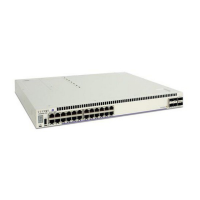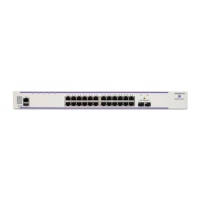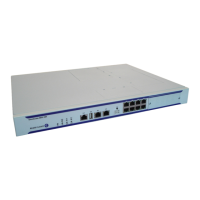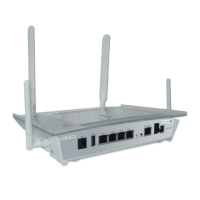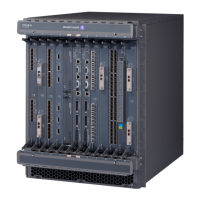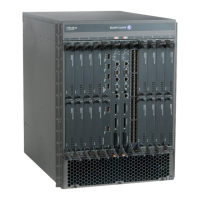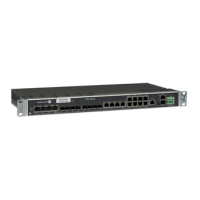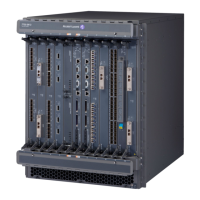Do you have a question about the Alcatel-Lucent OmniSwitch 6860E and is the answer not in the manual?
Information in this guide applies only to OmniSwitch 6860 switches.
Target audience: Network administrators and IT support personnel needing to configure, maintain, and monitor.
To familiarize yourself with switch hardware components and gain deeper understanding.
Covers availability features, technical specs, power requirements, airflow, and hardware CLI commands.
Each chapter focuses on specific hardware components or sets of components.
Focuses on initial setup and getting the switch running.
Covers hardware specs, procedures, and basic software features.
Guides on network configuration, VLANs, and routing protocols.
Lists titles and descriptions of all OmniSwitch 6860 user manuals.
Provides a complete reference to all CLI commands and their syntax.
Guides for switch management, network configuration, and advanced routing.
Information on 7x24 technical support, software updates, and hardware replacement.
Features that enhance resiliency and prevent data flow loss.
Information on power supply redundancy is detailed in Chapter 3.
Procedures for adding, removing, or replacing components without powering off.
Automatic sensor monitoring and user-driven CLI monitoring.
General procedures and requirements for installing the switch hardware.
Lists necessary tools like grounding strap and screwdrivers for installation.
Covers environmental and electrical requirements for the installation site.
Step-by-step guide for unpacking and installing the switch chassis.
Procedures for connecting network and management cables to the switch.
Process of powering on and booting the switch, including LED status.
Steps to complete the initial setup and configuration process.
Procedure for logging in with default admin credentials.
How to configure the IP address for the Ethernet Management Port (EMP).
Enabling remote access sessions like Telnet, FTP, and SNMP.
Steps to change the admin user login password for security.
Configuring time zone, date, time, administrative contact, and system name.
Command to save the current switch configuration.
Details and specifications for various OS6860 chassis models.
Front/rear panel views and specs for OS6860-24 and OS6860-48.
Front/rear panel views and specs for OS6860-P24 and OS6860-P48.
Front/rear panel views and specs for OS6860E series models.
Description of chassis status LEDs and their meanings.
General recommendations and procedures for mounting the switch.
Guidelines for ambient temp, airflow, mechanical loading, and earthing.
Minimum clearance requirements for proper airflow.
Step-by-step guide for mounting the chassis in a standard rack.
Procedures for placing the chassis as a standalone unit on a flat surface.
Details on different power supply types for OS6860 switches.
Specifications for AC, DC, 600W, and 920W power supplies.
Step-by-step guides for installing and removing power supplies.
Instructions on how to properly ground the chassis for safety.
Information on the supplemental cooling fan tray for non-PoE models.
How to view slot information and monitor chassis temperature.
CLI commands to view basic slot information.
How to check the switch's current temperature status.
Explanation of warning and danger thresholds for temperature.
Front and rear panel views of the OmniSwitch Backup Power Shelf/System.
Various configurations for using the OmniSwitch BPS with OS6860 switches.
Configurations that are not supported by the OS-BPS.
Chassis specifications for the OmniSwitch Backup Power Shelf/System.
How OS-BPS power supplies operate redundantly and can be hot-swapped.
Status LEDs on the OS-BPS chassis and their meanings.
Management of connector priority for power distribution in the OS-BPS.
General recommendations and procedures for mounting the OS-BPS chassis.
Guidelines for ambient temp, airflow, mechanical loading, and earthing.
Airflow path for OS-BPS power supplies and importance of blank panels.
Step-by-step guide for rack-mounting the OS-BPS chassis.
Details on AC and PoE power supplies for the OS-BPS.
Specifications for AC and PoE power supplies used in the OS-BPS.
Meaning of AC and PoE power supply LED states.
Connecting the OS-BPS to OS6860 switches.
Steps to connect OS-BPS to switches using DB25 cables.
Procedures for installing and connecting system power to the OS-BPS.
Procedures for disconnecting a switch from the OS-BPS.
Steps to remove system power supplies and PoE power cords.
Commands for viewing power supply info and connector priority.
Overview of PoE specifications, configuration, and monitoring.
General specifications for Alcatel-Lucent's Power over Ethernet support.
How to view current PoE status and settings for ports.
Lists default PoE configuration parameters and CLI commands.
How powered devices are classified and how class detection works.
Enabling PoE on ports and managing admin state.
How to set power allowance for individual ports and slots.
Specifying priority levels (low, high, critical) for ports.
Enabling/disabling capacitor detection for legacy IP phones.
Function of priority disconnect in tight power budget conditions.
How to enable or disable priority disconnect functionality.
Using CLI commands to monitor current PoE statistics and settings.
Compliance with EU directives and WEEE statement.
Table listing hazardous substances in electronic information products.
Overview of compliance with various safety and EMC standards.
List of safety standards the product complies with.
Lists EMI/EMC and environmental standards the product complies with.
Compliance with FCC Part 15 and Canadian Class A regulations.
Warnings for potential radio interference and compliance standards.
Warnings related to laser radiation and general safety.
Safety warnings translated into French, German, and Spanish.
Importance of installing blank cover panels for airflow and protection.
Warning against working with equipment during electrical storms.
Only knowledgeable personnel should install or maintain equipment.
Warning about invisible laser radiation from open apertures.
Warnings about voltage hazards and power disconnection before servicing.
Warnings regarding proper earthing and DC power supply connections.
References to the 'Getting Started Guide' and ESD precautions.
Information in this guide applies only to OmniSwitch 6860 switches.
Target audience: Network administrators and IT support personnel needing to configure, maintain, and monitor.
To familiarize yourself with switch hardware components and gain deeper understanding.
Covers availability features, technical specs, power requirements, airflow, and hardware CLI commands.
Each chapter focuses on specific hardware components or sets of components.
Focuses on initial setup and getting the switch running.
Covers hardware specs, procedures, and basic software features.
Guides on network configuration, VLANs, and routing protocols.
Lists titles and descriptions of all OmniSwitch 6860 user manuals.
Provides a complete reference to all CLI commands and their syntax.
Guides for switch management, network configuration, and advanced routing.
Information on 7x24 technical support, software updates, and hardware replacement.
Features that enhance resiliency and prevent data flow loss.
Information on power supply redundancy is detailed in Chapter 3.
Procedures for adding, removing, or replacing components without powering off.
Automatic sensor monitoring and user-driven CLI monitoring.
General procedures and requirements for installing the switch hardware.
Lists necessary tools like grounding strap and screwdrivers for installation.
Covers environmental and electrical requirements for the installation site.
Step-by-step guide for unpacking and installing the switch chassis.
Procedures for connecting network and management cables to the switch.
Process of powering on and booting the switch, including LED status.
Steps to complete the initial setup and configuration process.
Procedure for logging in with default admin credentials.
How to configure the IP address for the Ethernet Management Port (EMP).
Enabling remote access sessions like Telnet, FTP, and SNMP.
Steps to change the admin user login password for security.
Configuring time zone, date, time, administrative contact, and system name.
Command to save the current switch configuration.
Details and specifications for various OS6860 chassis models.
Front/rear panel views and specs for OS6860-24 and OS6860-48.
Front/rear panel views and specs for OS6860-P24 and OS6860-P48.
Front/rear panel views and specs for OS6860E series models.
Description of chassis status LEDs and their meanings.
General recommendations and procedures for mounting the switch.
Guidelines for ambient temp, airflow, mechanical loading, and earthing.
Minimum clearance requirements for proper airflow.
Step-by-step guide for mounting the chassis in a standard rack.
Procedures for placing the chassis as a standalone unit on a flat surface.
Details on different power supply types for OS6860 switches.
Specifications for AC, DC, 600W, and 920W power supplies.
Step-by-step guides for installing and removing power supplies.
Instructions on how to properly ground the chassis for safety.
Information on the supplemental cooling fan tray for non-PoE models.
How to view slot information and monitor chassis temperature.
CLI commands to view basic slot information.
How to check the switch's current temperature status.
Explanation of warning and danger thresholds for temperature.
Front and rear panel views of the OmniSwitch Backup Power Shelf/System.
Various configurations for using the OmniSwitch BPS with OS6860 switches.
Configurations that are not supported by the OS-BPS.
Chassis specifications for the OmniSwitch Backup Power Shelf/System.
How OS-BPS power supplies operate redundantly and can be hot-swapped.
Status LEDs on the OS-BPS chassis and their meanings.
Management of connector priority for power distribution in the OS-BPS.
General recommendations and procedures for mounting the OS-BPS chassis.
Guidelines for ambient temp, airflow, mechanical loading, and earthing.
Airflow path for OS-BPS power supplies and importance of blank panels.
Step-by-step guide for rack-mounting the OS-BPS chassis.
Details on AC and PoE power supplies for the OS-BPS.
Specifications for AC and PoE power supplies used in the OS-BPS.
Meaning of AC and PoE power supply LED states.
Connecting the OS-BPS to OS6860 switches.
Steps to connect OS-BPS to switches using DB25 cables.
Procedures for installing and connecting system power to the OS-BPS.
Procedures for disconnecting a switch from the OS-BPS.
Steps to remove system power supplies and PoE power cords.
Commands for viewing power supply info and connector priority.
Overview of PoE specifications, configuration, and monitoring.
General specifications for Alcatel-Lucent's Power over Ethernet support.
How to view current PoE status and settings for ports.
Lists default PoE configuration parameters and CLI commands.
How powered devices are classified and how class detection works.
Enabling PoE on ports and managing admin state.
How to set power allowance for individual ports and slots.
Specifying priority levels (low, high, critical) for ports.
Enabling/disabling capacitor detection for legacy IP phones.
Function of priority disconnect in tight power budget conditions.
How to enable or disable priority disconnect functionality.
Using CLI commands to monitor current PoE statistics and settings.
Compliance with EU directives and WEEE statement.
Table listing hazardous substances in electronic information products.
Overview of compliance with various safety and EMC standards.
List of safety standards the product complies with.
Lists EMI/EMC and environmental standards the product complies with.
Compliance with FCC Part 15 and Canadian Class A regulations.
Warnings for potential radio interference and compliance standards.
Warnings related to laser radiation and general safety.
Safety warnings translated into French, German, and Spanish.
Importance of installing blank cover panels for airflow and protection.
Warning against working with equipment during electrical storms.
Only knowledgeable personnel should install or maintain equipment.
Warning about invisible laser radiation from open apertures.
Warnings about voltage hazards and power disconnection before servicing.
Warnings regarding proper earthing and DC power supply connections.
References to the 'Getting Started Guide' and ESD precautions.
| Brand | Alcatel-Lucent |
|---|---|
| Model | OmniSwitch 6860E |
| Category | Network Router |
| Language | English |

